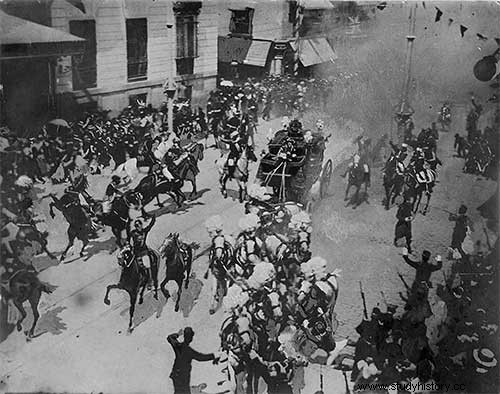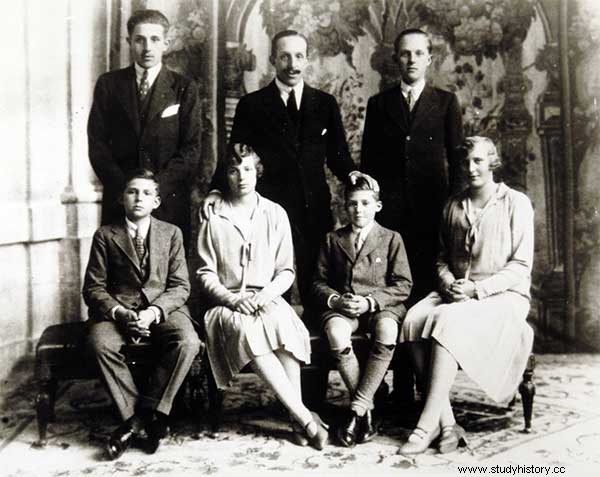Alfonso XIII was king of Spain . He was born on May 17, 1886 in Madrid, and was given the names of Alfonso León Fernando María Isidro Pascua Antonio de Borbón and Habsburg. He was the posthumous son of Alfonso XII and his second wife, María Cristina.
He was born almost six months after the death of his father; Therefore, when Alfonso XII died, a problem arose:it was up to the Princess of Asturias, María de las Mercedes, to be proclaimed queen; but, if the queen later had a son, María de las Mercedes would have to be removed from the throne; therefore, it was decided to wait for the birth of María Cristina, who was recognized as queen regent. On May 17, Alfonso XIII was born; this event was a cause of great rejoicing throughout Spain, as it guaranteed the succession of the monarchy. On that same date, he was proclaimed King of Spain, under the regency of María Cristina. , who, by a decree of 1886, definitively abolished slavery in Cuba. Spain was the last country in Europe to decree the abolition of slavery (as happened with the abolition of the Inquisition). Sabino Arana Goiri (1865-1903), from a Carlist family, founded the Basque Nationalist Party (PNV) in 1895.
Emancipationofthelastcolonies
In 1897, the emancipation movement began in Cuba; on February 15, 1898, the 5,600-ton armored cruiser Maine, belonging to the United States, was in the port of Havana and sank as a result of an explosion; for this cause or pretext, the United States declared war on Spain on April 18, 1898; This war also affected Puerto Rico and the Philippines, with the Treaty of Paris signed on December 10, 1898, by which Cuba, Puerto Rico and the Philippines came under the power of the United States; said peace treaty was ratified on April 11, 1899; Two months earlier (February 12, 1899), the Spanish government, presided over by Francisco Silvela y de Le Vielleuze (1845-1905), sold the archipelagos of the Carolinas, the Marianas and the Palau to Germany for twenty-five million pesetas.
Reign
On May 17, 1902, the king turned 17 years old and was declared of legal age; on that same date, he took an oath before the courts and took over power; then the regency of María Cristina ended . On July 18, 1909, the Carlist pretender, Carlos VII, died, and his followers recognized his son Jaime de Borbon, born in 1870, as the Carlist successor.
On December 27, 1910, the “Cañada Law” was approved, which prohibited, for two years, the establishment of new religious orders in Spain without the authorization of the Ministry of Grace and Justice. Between 1909 and 1927, the war in Africa took place; and, between 1914 and 1918, World War I; during this period of time, Alfonso XIII maintained the neutrality of Spain and, at the same time, carried out great humanitarian work in favor of prisoners of war belonging to belligerent countries. In March 1919, the eight-hour working day was introduced in Spain; Before this date, depending on the guilds, employers and circumstances, it was different on each occasion and could reach up to sixteen hours a day. In October of the same year, Spain entered the League of Nations. From 1923 to 1930, the dictatorship of General Primo de Rivera (1870-1930) developed. In 1926, the Plus Ultra made its flight . In 1927, the Canary Islands were divided into two provinces. On May 10, 1929, the Ibero-American Exhibition of Seville was inaugurated; and seven years later, the Barcelona International Exposition was inaugurated.
Marriage and descendants
On May 31, 1906, he had married Victoria Eugenia Julia (1887-1969), daughter of Prince Henry of Battenberg and Princess Beatrice of Great Britain; When the king and queen were returning from the wedding ceremony on Calle Mayor in Madrid, Mateo Morral threw a bomb at them, which killed 23 people and injured many more; but it did not reach the kings. From this marriage, were born:Alfonso (May 10, 1907), Jaime (June 23, 1908) Beatriz Isabel (June 22, 1909), María Cristina Teresa (December 12, 1911), Juan ( on June 20, 1913) and Gonzalo (on October 24, 1914). He also had a bastard son with actress Carmen Ruiz Moragas, named Leandro, born in 1929; On May 29, 2003, he was officially recognized and given the surname "de Borbón".

Proclamationofthesecondrepublic
On January 30, 1930, General Primo de Rivera resigned, which ended his dictatorship; then the king commissioned General Bereneuer (appointed president of the Council of Ministers) to prepare the return to the constitutional regime prior to 1923 .
On August 18, 1930, the representatives of the Republican parties met in San Sebastian and signed the Pact of San Sebastian, to establish a parliamentary republic, which would prepare the Statute of Autonomy for Catalonia. The leaders of the parties that signed that Pact were:Alejandro Lerroux (Republican Alliance), Manuel Azaña (idem), Marcelino Domingo (Radical Socialist Republican Party), Álvaro de Albornoz (idem), Ángel Galarza (idem), Niceto Alcalá Zamora (Republican Liberal Right), Miguel Maura (idem), Manuel Carrasco Formiguera (Catalan Action), Matías Mallol (Republican Action of Catalonia), Jaime Ayguadé (Estat Catalá) and Santiago Casares Quiroga (Galician Republican Federation); determined that a Revolutionary Committee he would organize a military uprising, which the people would support; the PSOE, UGT and CNT joined that project two months later. On Sunday, April 12, 1931, municipal elections were held; Only men over twenty-five years of age voted; only 66.9% voted. In 41 provincial capitals (including Madrid and Barcelona), the victory went to the Republicans; but, in the global calculation, the monarchists won, who obtained 40,275 councilors against 26,563 republican councilors (R. C.); however, the republicans considered that their triumph in the most important cities was enough to proclaim the Republic; on the 13th, crowds invaded the streets of the cities cheering the Republic; Admiral Aznar (President of the Government) said to a journalist:“What do you want me to tell you when a people goes to bed as a monarchist and rises up as a republican!”
On the 14th, the King authorized the Count of Romanones (member of the Government) to have an interview with Alcalá Zamora, which was held at Dr. Marañón's house. Alcalá Zamora demanded that Alfonso XIII leave Madrid before sunset that same day, and that the transfer of powers be made the following day. . Therefore, on April 14, 1931, the Revolutionary Committee proclaimed the Second Republic in Madrid and became the Provisional Government, the king left Madrid at a quarter past eight on his way to Cartagena, to begin his exile.
Exile of Alfonso XIII
Alfonso XIII, before leaving, left the following message:«in order not to... throw one compatriot against another in a fratricidal civil war..., I am deliberately suspending the exercise of royal power and withdrawing from Spain. …” . In Cartagena, the royal family boarded the Prince Alfonso' cruise ship, which took them to Marseille. Later he went to Paris, where, in this same year, Jaime de Borbón (the Carlist pretender) visited Alfonso XIII and reconciled with him; but Jaime de Borbón died on October 2 of that same year, 1931; His followers then chose Alfonso Carlos (Jaime's uncle and brother of Carlos María de los Dolores) as his successor, who died without issue on September 28, 1936, so that, on this date, the legitimate Carlist branch became extinct. direct; thus, by the Salic Law (because of which the existence of Carlism began), the Carlist succession passed to Alfonso XIII, but, on January 23, 1936, Alfonso Carlos had appointed his nephew Jaime de Borbón Parma (son of of Roberto, Duke of Parma and brother of Margarita, wife of Carlos María de los Dolores). Later, Alfonso XIII established his residence in Rome, where he died on February 28, 1941 .

Abdication to the crown
“In June 1933, the succession of the Spanish Crown fell to Don Juan de Borbón, after the resignations of his two older brothers, Don Alfonso and Don Jaime. […] Thus, on January 15, 1941, Don Alfonso XIII signed his abdication in Rome. Hardly a month had passed when the sovereign died, victim of angina pectoris, and Don Juan, Head of the Spanish Royal House, adopted the title of Count of Barcelona, inherent to the holder of the Crown of Spain. Don Juan de Borbón himself recalls that historical event in this way:“Due to special circumstances known to all, this sacred deposit fell on me and King Alfonso XIII, on January 15, 1941, in his abdication manifesto, said:' I offer my country the renunciation of my rights so that by historical law of succession to the Crown my son Prince Don Juan, who embodies in his person the monarchical Institution and who will be the tomorrow, when Spain deems it appropriate, the King of all Spaniards'. In January 1980, Don Juan de Borbón brought the mortal remains of his father from Rome to the El Escorial Monastery, where he himself was also buried on April 4, 1993 , having died three days earlier.
